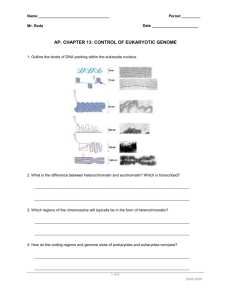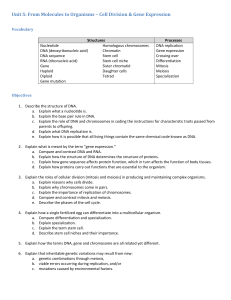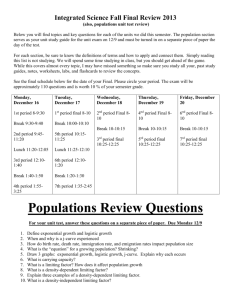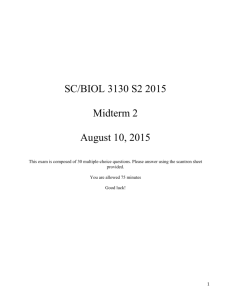AP Biology Exam Review T2 - Nyland-2013-14
advertisement
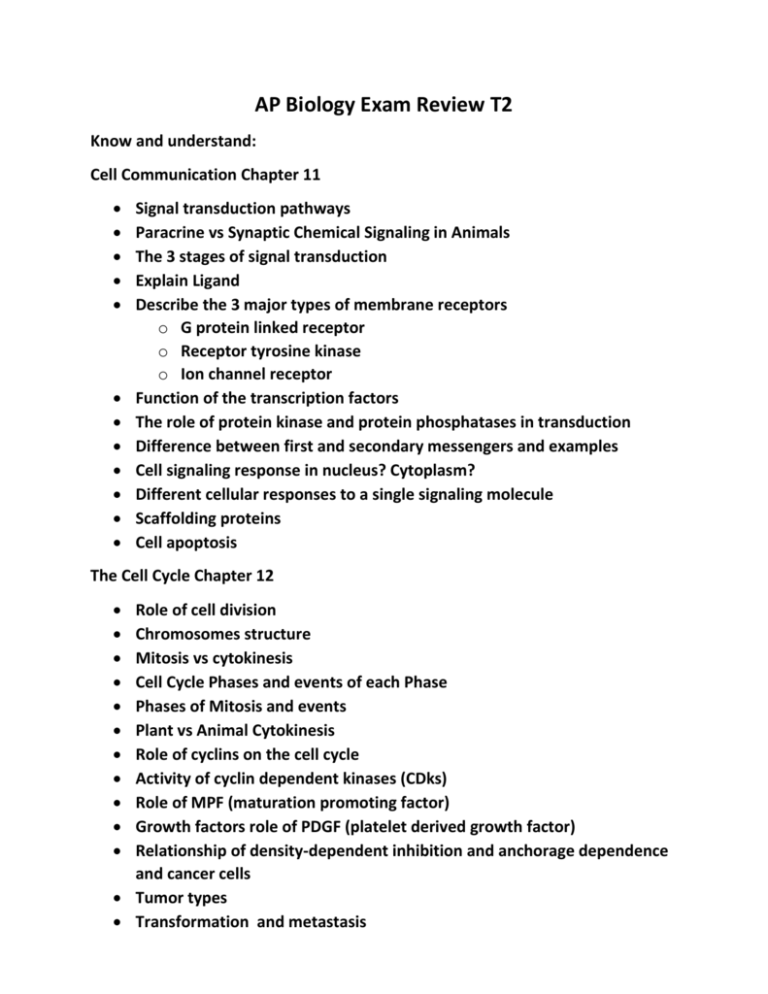
AP Biology Exam Review T2 Know and understand: Cell Communication Chapter 11 Signal transduction pathways Paracrine vs Synaptic Chemical Signaling in Animals The 3 stages of signal transduction Explain Ligand Describe the 3 major types of membrane receptors o G protein linked receptor o Receptor tyrosine kinase o Ion channel receptor Function of the transcription factors The role of protein kinase and protein phosphatases in transduction Difference between first and secondary messengers and examples Cell signaling response in nucleus? Cytoplasm? Different cellular responses to a single signaling molecule Scaffolding proteins Cell apoptosis The Cell Cycle Chapter 12 Role of cell division Chromosomes structure Mitosis vs cytokinesis Cell Cycle Phases and events of each Phase Phases of Mitosis and events Plant vs Animal Cytokinesis Role of cyclins on the cell cycle Activity of cyclin dependent kinases (CDks) Role of MPF (maturation promoting factor) Growth factors role of PDGF (platelet derived growth factor) Relationship of density-dependent inhibition and anchorage dependence and cancer cells Tumor types Transformation and metastasis Meiosis and Sexual Life Cycles Chapter 13 Basic vocab o Gene o Loci o Gamete o Somatic cells o Karyotype o Diploid o Haploid o Homologous chromosomes o Zygote Purpose of meiosis Events and chromosome numbers of meiosis Including vocab o o o o o o Crossing over Synapse Chiasmata homologs replicated chromosomes sister chromatids Mendel and the Gene Idea Chapter 14 Mendel’s studies o P, F1, F2 o Dominant and recessive o Hetero/homo-zygous o Alleles o Punnett squares o Mono/di-hybrid o Law of segregation and Independent Assortment o Use of probability Co-dominance Incomplete Dominance Multiple Alleles/Blood Type Polygenetic traits The Chromosomal Basis of Inheritance-Chapter 15 Chromosome theory of inheritance Sex linked SRY Barr Body Linked genes Linkage Map Units Nondisjunction How do Deletion, duplication, inversion and translocation effect inheritance Mitochondrial Inheritance The Molecular Basis of Inheritance-Chapter 16 Structure of the DNA molecule o Nucleotides o Bases o Bonds o Backbone o Purines o Pyrimidines o Double helix o Antiparallel o Chargaff’s rules DNA Replication o Origins of replication o Leading lagging strands o RNA primer o Helicase o SSBP o Topoisomerase o DNA polymerase o DNA ligase o Semi-conservative o Telomeres/telomerase DNA Structure o Chromatin o Chromosome o Histones charges and reason tightly binds to DNA o Nucleosomes o Looped domains o 30 nm fiber o Double helix o Hetero/eu-chromatin From Gene to Protein-Chapter 17 Central Dogma RNA vs DNA Explain transcription o Tata box, Promoter, RNA polymerase, transcription unit, RNA o Initiation, elongation, termenation Explain RNA processing o End caps o Introns/exons o Spliceosomes/snurps Ribozyme Alternative splicing Explain translation o Codon/anticodon o Charged/uncharged tRNA o initiation, elongation, termination o APE sites of ribosome o Wobble o Polyribosome Post-translation modifications Mutations o Point o Framshift o Nonsense o Missense o Silent o Causes Differences between bacterial and eukaryotic gene expression Regulation of Gene Expression-Chapter 18 Operons o Negative inhibition/positive o Promoter o Repressor o Operator o Gene o Regulatory gene o Inducible/repressible o Inducer o Trp vs lac operons CAP (catabolic Activator Protein)/cAMP, glucose relationship Differential gene expression Role of histone modification/DNA methylation on eukaryotic gene expression Explain how enhancers and activator interact with transcription factors to affect gene expression Describe how proteins can be activated, processed and degraded. Describe the proteasomes action and role in gene expression Describe microRNA/siRNA and their role in gene expression 3 processes that lead to transformation of a zygote to an organism Cell differentiation cause Differential gene expression results from different activitors-cyctoplasmic determinants and inductive signals Homeotic genes Oncogenes and proto-oncogenes Oncogenes /tumor suppressor genes Viruses-Chapter 19 Characteristics of viruses Structure of viruses Obligate parasites Lytic cycle Lysogenic cycle Prophage/provirus Types of genetic material o DNA o RNA retrovirus, reverse transcripase Restriction enzymes How do virus cause illness/prevention How do viruses emerge Horizontal /vertical transmission Plant viral spread Virod Prion




